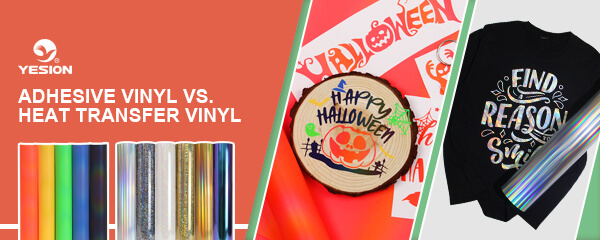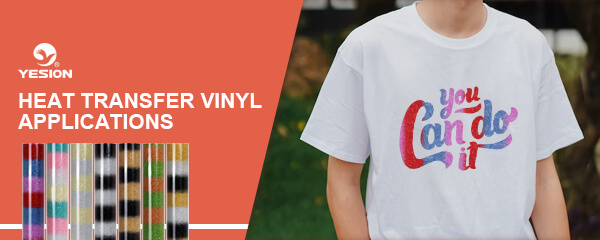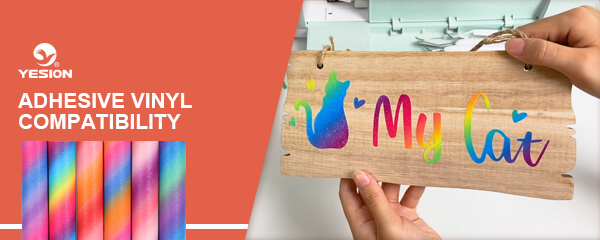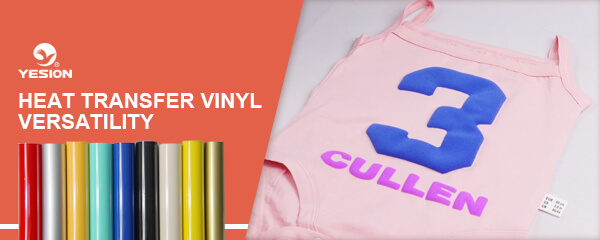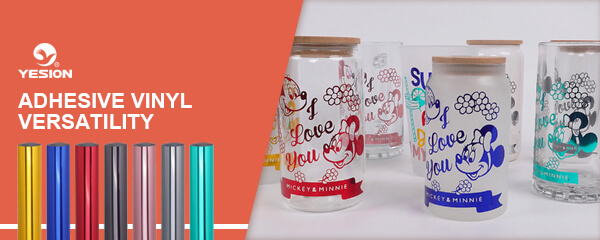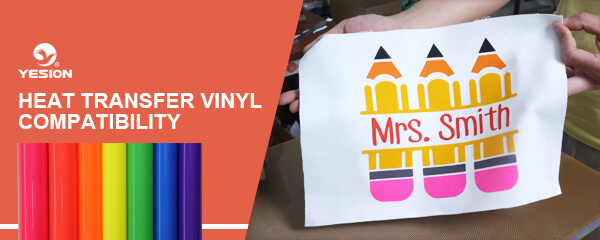
Tips for Properly Storing Adhesive Vinyl Rolls
2023-08-01
Common Issues with Adhesive Vinyl Applications
2023-08-08When it comes to crafting and decorating, vinyl is a versatile and widely used material. However, choosing between adhesive vinyl and heat transfer vinyl can be perplexing, especially for beginners. Both vinyl types have distinct properties and applications, making them suitable for different projects. In this article, we will delve into the details of adhesive vinyl and heat transfer vinyl to help you make an informed decision. So, let’s explore the key differences and find out which one is the right choice for your creative endeavors.
Adhesive Vinyl vs. Heat Transfer Vinyl: A Comprehensive Comparison
In this section, we will provide a comprehensive comparison between adhesive vinyl and heat transfer vinyl. We will cover various aspects of each type, including their uses, application methods, durability, and more.
Adhesive Vinyl: An Overview
Adhesive vinyl, also known as sticker vinyl, is a self-adhesive material used for a wide range of applications. It comes in various finishes, including glossy, matte, and specialty textures. Adhesive vinyl is popular among crafters, DIY enthusiasts, and professionals due to its ease of use and versatility.
Heat Transfer Vinyl: An Overview
Heat transfer vinyl, often referred to as HTV, is a type of vinyl used for transferring designs onto fabrics and textiles. Unlike adhesive vinyl, which sticks to surfaces, HTV requires heat and pressure to adhere to fabrics. It comes in a wide array of colors and finishes, making it a favorite choice for personalized apparel and accessories.
Applications: Where to Use Adhesive Vinyl and Heat Transfer Vinyl?
In this section, we will explore the various applications of both adhesive vinyl and heat transfer vinyl. Understanding their best uses will help you decide which vinyl type is suitable for your project.
Adhesive Vinyl Applications
Home Decor: Adhesive vinyl is perfect for adding decorative elements to walls, windows, mirrors, and furniture. Create custom decals and wall art to give your living space a unique touch.
Craft Projects: Crafters love adhesive vinyl for creating custom stickers, labels, and decals for scrapbooking, card making, and other craft projects.
Vehicle Decals: Use adhesive vinyl to design and apply eye-catching decals to personalize your car, motorcycle, or any other vehicle.
Signage: Adhesive vinyl is commonly used for creating indoor and outdoor signs for businesses, events, and promotions.
Related link:
A Beginner’s Guide to Crafting with Adhesive Vinyl
Heat Transfer Vinyl Applications
Custom Apparel: HTV shines in customizing t-shirts, hoodies, hats, and other clothing items. Design your unique apparel or add logos and team names to uniforms.
Bags and Accessories: Personalize bags, totes, and accessories like caps and aprons with vibrant heat transfer vinyl designs.
Sports Jerseys: HTV is an excellent choice for adding names, numbers, and logos to sports jerseys, making them stand out on the field.
Home Textiles: Create personalized throw pillows, cushions, and blankets with heat transfer vinyl to add a personal touch to your home decor.
Related link:
26 Trendy Designs for Heat Transfer Vinyl
Application Methods: How to Use Adhesive Vinyl and Heat Transfer Vinyl?
Both adhesive vinyl and heat transfer vinyl require different application methods. Let’s take a closer look at how to use each type effectively.
Using Adhesive Vinyl
Prepare the Surface: Clean and dry the surface where you intend to apply the adhesive vinyl. Ensure it is free from dust and debris.
Design and Cut: Create or select your design using a vinyl cutting machine or by hand. Adjust the settings and cut the design on the adhesive vinyl sheet.
Weed the Design: Remove the excess vinyl from the backing sheet using a weeding tool, leaving only the desired design.
Transfer the Design: Apply transfer tape over the design and gently press it down. Peel off the backing paper, leaving the vinyl design on the transfer tape.
Apply the Vinyl: Carefully position the transfer tape with the vinyl design on the surface. Press down the vinyl using a squeegee or credit card to ensure it adheres smoothly.
Remove the Transfer Tape: Peel off the transfer tape, leaving the adhesive vinyl design on the surface.
How To Use Adhesive Vinyl on Acrylic Keychains DIY Craft Tutorials With Cricut?
Using Heat Transfer Vinyl
Design and Cut: Create or choose your design and mirror the image using design software. Cut the design on the heat transfer vinyl sheet using a cutting machine.
Weed the Design: Remove the excess vinyl from the backing sheet, leaving only the desired design. Use a weeding tool for precision.
Preheat the Fabric: Preheat the fabric to remove any moisture and wrinkles, ensuring a smooth application.
Position the Design: Place the HTV design on the fabric, ensuring it is in the desired position.
Apply Heat and Pressure: Use a heat press machine or a household iron to apply heat and pressure to the HTV. Follow the manufacturer’s instructions for temperature and time settings.
Peel off the Backing: After applying heat, carefully peel off the plastic backing, leaving the design adhered to the fabric.
Follow VISION youtube video to learn more heat transfer vinyl applications.
Durability: How Long Do Adhesive Vinyl and Heat Transfer Vinyl Last?
The durability of vinyl is an essential factor to consider when choosing between adhesive vinyl and heat transfer vinyl. Each type has its strengths and limitations in terms of longevity.
Adhesive Vinyl Durability
Adhesive vinyl is durable for both indoor and outdoor use. Depending on the quality of the vinyl and the environmental conditions, Yesion adhesive vinyl can last from 3 (outdoor) to 5 (indoor) years or more. For outdoor applications, consider using UV-resistant adhesive vinyl for extended longevity.
Heat Transfer Vinyl Durability
HTV is highly durable on fabrics when applied correctly. With proper care, the designs can withstand numerous wash cycles without fading or peeling. However, HTV is not ideal for long-term outdoor use, as exposure to harsh weather conditions may cause the design to deteriorate.
Compatibility: Which Surfaces and Fabrics are Suitable?
Another critical consideration is the compatibility of each vinyl type with different surfaces and fabrics.
Adhesive Vinyl Compatibility
Adhesive vinyl adheres well to smooth and flat surfaces such as glass, metal, plastic, and painted wood. It may not adhere effectively to highly textured or uneven surfaces.
Heat Transfer Vinyl Compatibility
HTV works best on fabrics with a high cotton content, such as cotton, polyester, and cotton-poly blends. It is not suitable for fabrics that cannot withstand the heat required for application, such as delicate silk or nylon.
Washability: How to Care for Adhesive Vinyl and Heat Transfer Vinyl Projects?
Proper care and maintenance are essential for preserving the quality and longevity of vinyl projects.
Adhesive Vinyl Washability
Adhesive vinyl is generally water-resistant and can withstand mild cleaning with a damp cloth. However, it is not dishwasher-safe or suitable for aggressive scrubbing.
Heat Transfer Vinyl Washability
HTV designs on fabrics are durable and withstand regular machine washing. Always wash inside out in cold water with mild detergent, and avoid using bleach or fabric softeners.
Cost Comparison: Which Vinyl Type is More Economical?
The cost of vinyl is a significant factor, especially for large-scale projects. Let’s compare the costs of adhesive vinyl and heat transfer vinyl.
Adhesive Vinyl Cost
Adhesive vinyl is generally more affordable than heat transfer vinyl. The pricing varies depending on the brand, quantity, and size of the vinyl sheets.
Heat Transfer Vinyl Cost
Heat transfer vinyl is slightly more expensive due to its specialized use on fabrics. Additionally, larger designs may require more vinyl, contributing to higher costs.
Ease of Use: Which Vinyl Type is More User-Friendly?
For beginners and hobbyists, the ease of use is a crucial consideration when choosing vinyl types.
Adhesive Vinyl Ease of Use
Adhesive vinyl is user-friendly and suitable for crafters of all levels. It requires minimal equipment and can be applied to various surfaces with ease.
Heat Transfer Vinyl Ease of Use
HTV requires a bit more skill and specific equipment like a heat press. While it may seem intimidating at first, with practice, it becomes manageable.
Versatility: Which Vinyl Type Offers More Creative Options?
The creative possibilities offered by each vinyl type play a significant role in deciding the best fit for your projects.
Adhesive Vinyl Versatility
Adhesive vinyl offers versatility in crafting and decorating. It can be applied to various surfaces and used for a wide range of projects, making it an excellent choice for home decor, gifts, and small business applications.
Heat Transfer Vinyl Versatility
HTV shines in customizing apparel and fabrics. Its ability to create personalized designs on clothing items makes it perfect for fashion, team uniforms, and promotional merchandise.
Which Vinyl Type to Choose: Summary of Considerations
After comparing adhesive vinyl and heat transfer vinyl in various aspects, let’s summarize the key factors to consider when making your decision:
Project Type: Choose adhesive vinyl for surfaces and heat transfer vinyl for fabrics and textiles.
Application Method: Adhesive vinyl is applied directly, while HTV requires heat and pressure for transfer.
Durability: Adhesive vinyl lasts longer outdoors, while HTV withstands washing on fabrics.
Compatibility: Adhesive vinyl adheres to smooth surfaces, and HTV works best on cotton-based fabrics.
Washability: Adhesive vinyl is water-resistant, and HTV designs endure regular machine washing.
Cost: Adhesive vinyl is more budget-friendly, while HTV is slightly more expensive.
Ease of Use: Adhesive vinyl is user-friendly, while HTV requires specific equipment and skills.
Versatility: Adhesive vinyl suits various projects, while HTV excels in fabric customization.
Related:
What is the difference between adhesive vinyl and heat transfer vinyl
Choosing between adhesive vinyl and heat transfer vinyl depends on your specific projects and preferences. Adhesive vinyl is excellent for general crafting and surface applications, while heat transfer vinyl adds a personalized touch to fabrics and textiles. Consider the factors discussed in this article, such as durability, application method, washability, and cost, to make an informed choice. Embrace your creativity and start crafting with the perfect vinyl for your unique projects!
Frequently Asked Questions
Yes, you can apply adhesive vinyl on fabric for temporary designs. However, it is not suitable for long-term use on textiles like heat transfer vinyl.
While HTV is specifically designed for fabrics, some crafters have experimented with using it on hard surfaces. However, it may not adhere as effectively as adhesive vinyl.
To preserve the quality of vinyl, store leftover sheets in a cool, dry place away from direct sunlight and extreme temperatures.
HTV is safe for children’s clothing, provided it is properly applied and washed according to care instructions.
Yes, HTV allows you to create multi-color designs by layering different vinyl sheets.
HTV works best on fabrics with a high cotton content. It may not adhere well to fabrics like silk or nylon.

